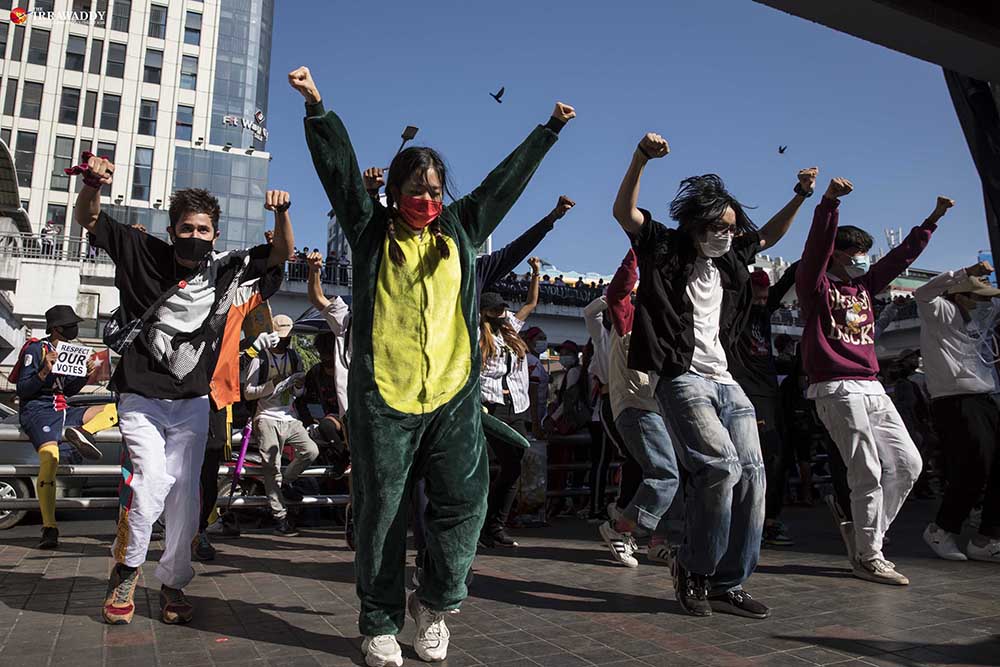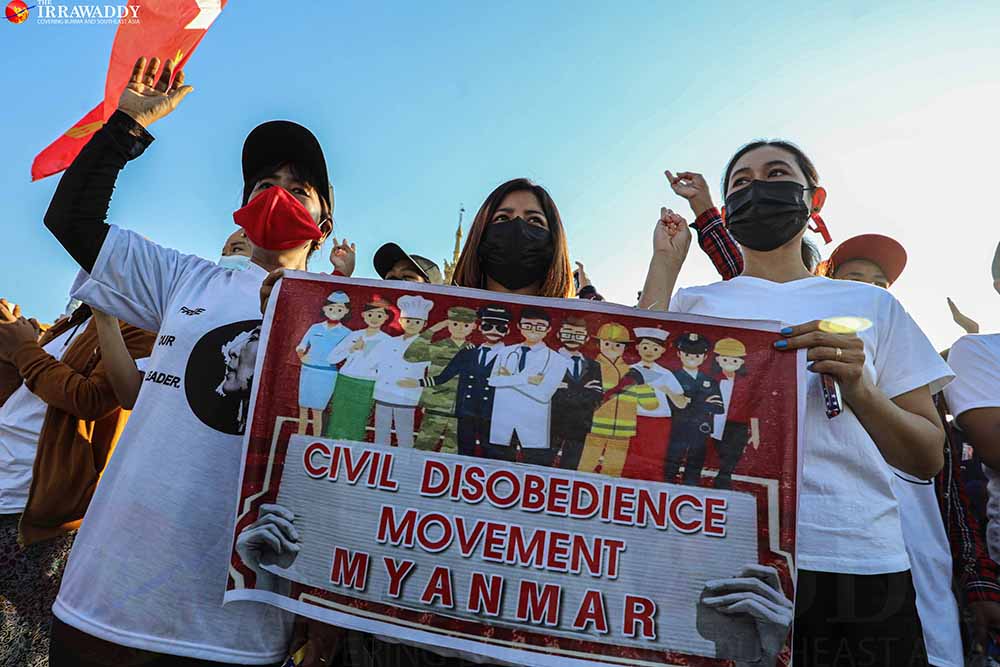Differing from the nationwide uprisings in 1988 and 2007, the mass movement which began a few days after the military staged a coup on Feb. 1 has been lively, entertaining and intriguing, indeed. Those who are staging it are the latest generation, Generation Z (or “Gen-Z” as they are affectionately known by the public), mostly comprising teenagers and 20-somethings.
The essence of their demands is exactly the same as that of the older generations—“Down with the military dictatorship”—but the forms are different.
This uprising looks like a street performance with colorful costumes, stylish fashions and weird wizards abounding. But we can all see how serious and determined these young people are on their mission to eradicate the military dictatorship and return to democracy.
“Why I am protesting here is because we can’t sit idle, doing nothing against the military dictatorship. The entire country must revolt against it,” said 17-year-old university student Yumi San, who has been protesting on the streets for the past four days at Hledan Junction, Yangon.
“The generation of my mother lost to U Than Shwe [the chief of the ex-military regime] and in my grandmother’s era they lost to U Ne Win [the late dictator and general],” the English major told The Irrawaddy. “This is our turn and we have to defeat [coup leader Senior General] Min Aung Hlaing. Or else, we—another generation—will also lose our future.”
Like her, 20-year-old protester Theint Myat Chae has been protesting for days. She is a third-year university student and cast her first vote for the National League for Democracy (NLD) led by Daw Aung San Suu Kyi in the last election. “We can’t accept this military coup. People cast their votes democratically. We dislike the military’s unjust act.”
These two students are among the young protesters who have taken to the streets in the hundreds of thousands in Yangon alone over the past seven days. This young generation is the main force behind the current uprising against the military dictatorship. This fresh force and their creative resistance is something the coup leaders cannot have foreseen.
That means the generals haven’t learned the lessons from the history of their own country.
The youth have always been at the forefront of nationwide political movements against any type of injustice here in Myanmar, from the British colonizers to consecutive military regimes over the past century. Across the generations, they have been consistently courageous.
As young students, they have historically been at the forefront. The fighting peacock, a flag representing historic student unions, has been a symbol of the struggles for independence, freedom and democracy throughout the country’s history—the flags of the Students’ Union and the NLD both carry the fighting peacock.

Young people stage an anti-coup performance in downtown Yangon on Feb. 11. / The Irrawaddy
But what sets Generation Z apart from previous generations is that they are armed with an awareness of the internet, social media and tech trends around the world, which they picked up over the past decade after the previous military dictatorship started loosening its grip on power.
This latest uprising against the military dictatorship really needs their creative force, IT savvy and other skills. But Generation Z seems to know what they are doing and where they stand in this uprising.
Generation Z backed the leading political force in the country prior to the coup—the NLD and its elected leaders.
Four forces
In this uprising, I see the mass movement comprising four key forces—Generation Z; the previous political generations, including the ’88 generation guided by prominent student leader Ko Min Ko Naing; civil servants staging the civil disobedience movement, or CDM; and the elected NLD. The public is together with them.
These four key forces have been separately leading this current uprising. Yes, they are operating separately but we could say they are working in harmony.
Simply look at their major demands—“Down with the military dictatorship!” “Free Our Leaders [Daw Aung San Suu Kyi and President U Win Myint]!” “Respect our votes!” and so on. But if you extract the core of the demands, what they are demanding is that the military regime step down, free elected leaders and hand over power to the party they voted for in the election in 2020.
I said they are in harmony because they are not competing with each other but complementing each other. They are not crossing a line which is set democratically. In other words, they clearly see the NLD as not only their leading political force, but also the only group with a legitimate mandate from the people to form a government.
The mass movement steered by these four key forces has the sole goal of rejecting the military dictatorship and restoring democracy and the elected leaders of the NLD. That’s it.
To prove this analysis, we can look at what the military regime has been doing against these resistance forces since it took power on Feb. 1.
Since Day 1, its first and main target has been the NLD and its leaders. They arrested de facto leader Daw Aung San Suu Kyi and President U Win Myint right away with some key members of the party. Since then, especially at night, they have continued to arrest members of the NLD, including ministers and chief ministers across the country. So far, more than 120 NLD leaders and leading members have been detained.
On the night of Feb. 9, the military raided the NLD headquarters in Yangon. According to the head of the party’s headquarters, U Soe Win, military personnel broke down doors to gain entry, destroyed CCTV cameras and computer servers and seized savings passbooks and money from a safe. Earlier, the military had also raided other NLD offices in different cities.
Many elected members have gone into hiding in an effort to continue their political activities. From their hideouts, they seem to have been quite active, releasing political statements to the public.
This targeted crackdown by the military against the NLD shows that the party is its main enemy, simply because of its legitimacy and the fact that it has the people’s support. That’s what they need to counter right away, in order to show to the public and the world that the military coup has “legitimacy”.

People support the Civil Disobedience Movement in Mandalay on Feb. 10. / The Irrawaddy
The second group the military regime is targeting is civil servants who have actively taken part in the CDM, whose momentum is building. The other forces—Generation Z, the ’88 generation led by Ko Min Ko Naing, and the NLD itself—keep calling for all civil servants to join the movement in order to stop all operations of the military regime. A number of civil servants—significantly at the Ministry of Health—have joined it, and the movement has affected the government’s operations to some extent.
In the 12 days since the military takeover, coup leader Snr-Gen Min Aung Hlaing has made two public speeches, in which he requested that civil servants return to work. On Friday night, the police raided the houses and hospitals of some civil servants to force them to return to work. But their efforts have failed so far.
Other leading activists including Ko Min Ko Naing and free members of the NLD are a politically strategic group, as their requests to the public are quite influential. The regime will definitely have them on its mind, but hasn’t been able to crack down against them yet as they have been in hiding.
Meanwhile, the military regime has yet to heavily crack down against Generation Z and the protesters on the streets despite dozens of arrests nationwide since the demonstrations began on Feb. 7. It doesn’t mean that the generals are tolerant of them and their creative demonstrations. The generals are simply busy targeting more important “enemies”.
Sooner or later, the military regime will directly crack down on Generation Z and other protesters on the streets with heavy force. But the young generation is likely to come up with more creative ways to counter it, to keep working towards their goal of rejecting the military dictatorship and restoring democracy and the leaders they elected.
Generation Z—surprise the older generations and the world!
Kyaw Zwa Moe
 Europe Solidaire Sans Frontières
Europe Solidaire Sans Frontières


 Twitter
Twitter Facebook
Facebook